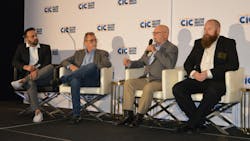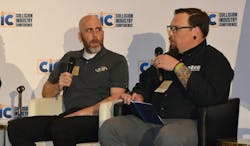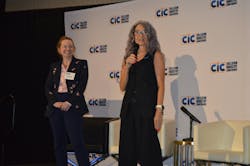As they increase across the country, total losses were the theme of the day for the Collision Industry Conference (CIC), July 23 in Philadelphia. Most presentations of the day focused on issues related to total losses — which have increased because of increased vehicle complexity and thus severity — plus high salvage values being paid for vehicles by overseas bidders.
Serving a Fickle Consumer
Liz Stein, vice president of strategic initiatives at Certified Collision Group and co-chair of CIC’s OEM Industry Relations Committee, pointed out some headwinds to the collision repair industry, with more consumers “upside down” on their car loans than ever.
“And the new drivers that are emerging are not necessarily tied to vehicle ownership, or even leasing a vehicle. They're open to alternative ways of being able to drive a vehicle.” Short-term car rentals, such as Zipcar, or mass transportation appeal to 44% of 18-34-year-olds, she said. So when a vehicle totals, some owners are ready to do away with car ownership altogether.
“The only way that we're going to be able to solve this — because it is a complex issue — is to be able to work together,” she said, including working with local suppliers to possibly get parts cost down for an estimate that’s on the cusp of totaling.
Fickle consumers switch vehicle brands more than ever, which concerns OEMs. So, once a vehicle is totaled, Stein suggested having a system in place to help keep the vehicle owner brand-loyal.
“If you have a close relationship with a dealer as a certified shop for them and you do their work, what about negotiating a special program?” ‘You check in with Chris and you get the friends and family discount, and I'm going to make that call right now and you don't have to go through any of the hassles.’ Do you think the consumer would appreciate that effort would go through that? I think they would. And also, wouldn't that deepen your relationship with that particular dealer?”
Can Laws Be Changed to Reduce Totals?
Auto Body Association of Texas Executive Director Jill Tuggle was moderator of the Governmental Committee’s presentation, which examined how state laws vary on salvage titling and how to determine total losses.
“The total loss threshold is the cost to repair a vehicle greater than a percentage of the vehicle's actual cash value, and then the total loss formula is where the insurer would lose more money repairing the vehicle than it would paying the policyholder the ACV of the vehicle and selling the vehicle in a post-collision condition,” Tuggle said.
Panelist David Willett, chief underwriting officer at Spark Underwriters, suggested that current laws, written to address structural totals, are outdated with the addition of technology features such as ADAS and the labor required to restore their functionality. And if those vehicles are repaired, in many cases they suffer from having a “branded” title, such as being designated as “prior salvage.”
“[The OEMs] are coming up with the how-to of repairing a car. Shouldn’t they be coming up with how to total-loss a car?”
He acknowledged it’s a bit of shift in thinking. “But it seems to me there ought to be more reliance upon the engineers of the OEs and the OE-certified repairers in making that determination.”
The Total Loss Process
A later presentation focused on the process for total losses, with panelists from an OEM, an independent repairer, salvage pool, and insurer providing perspectives on their role in the process.
The total loss process is complex and requires coordination with multiple parties, and shop operators should be proactive in helping customers understand their rights and policy details. Kye Yeung, president of European Motor Car Works in Costa Mesa, California, said customers often don’t understand their rights and policy details, something shop operators can assist with. Andrew, Batenhorst, body shop manager of Pacific BMW in Glendale, California, said his staff “have to educate the customer on some of these things, as they're not getting that information from their adjuster.”
For Batenhorst, that is not just best practice; it’s a legal requirement by the California Bureau of Automotive Repair.
“On July 1st, a new law went into a place where we have to define what area of the car that we're going to be diagnosing in layman's terms that a customer can understand. And that translates into the total loss process. Because in the event that goes that route, if an insurer disagrees with the extent of disassembly that we went through, we could end up getting investigated by the BAR later on.”
Additional Reading: Don't Lose on Total Losses at Your Collision Repair Shop
About the Author
Jay Sicht
Editor-in-Chief, FenderBender and ABRN
Jay Sicht is editor-in-chief of FenderBender and ABRN. He has worked in the automotive aftermarket for more than 29 years, including in a number of sales and technical support roles in paint/parts distribution and service/repair. He has a bachelor's degree in journalism from the University of Central Missouri with a minor in aviation, and as a writer and editor, he has covered all segments of the automotive aftermarket for more than 20 of those years, including formerly serving as editor-in-chief of Motor Age and Aftermarket Business World. Connect with him on LinkedIn.
Don't miss Jay's next article or podcast. Sign up for FenderBender Today's Collision Repair News and ABRN eNews here.





